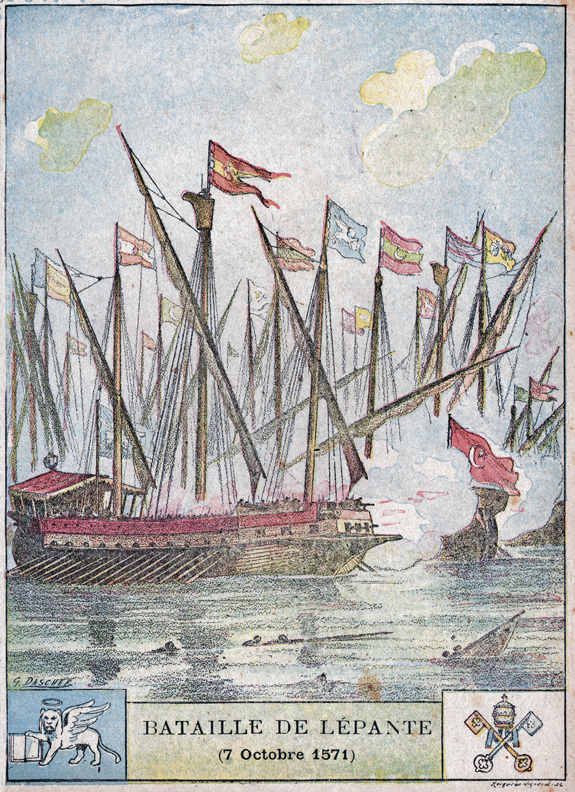by Carol Glatz

VATICAN CITY (CNS) – One could say it all started with St. Peter’s fishing boat. One day, that humble vessel turned into a powerful pontifical fleet, particularly during the life of the Papal States.
While St. Peter’s boat was clearly used for fishing and helping Jesus preach to the crowds on shore, the papal navy was decidedly used for defense, conquest and commerce.
Historians believe the pontifical navy was established in the 10th century by Pope John VIII.
Popes Nicholas V and Sixtus IV sent military ships against the Turks during the Ottoman wars, and the “St. Bonaventure” was commissioned by Pope Sixtus V to fight seafaring pirates in the 16th-century.
The armed frigates, corvettes, steamers and schooners were blessed with the names of the saints, the most popular being “St. Peter” and “St. Paul.” At least one was named for a female saint, St. Firmina, and one gunboat was called the “Immaculate Conception.”
The fleet was beefed up when the Papal States were under considerable threat, first by the French in the 18th century and then by burgeoning Italian nationalism in the 19th century.
Armed papal ships guarded the Italian port of Civitavecchia and cruised the waters of the Adriatic and Mediterranean seas in search of contraband. Three paddle steamers built in England joined the fleet in 1842 to run upstream the Tiber River, a major route for bringing commercial goods and materials to Rome.
Another paddle ship joined the ranks, and in 1848, the ships were used to fight nationalist forces that sought to end the popes’ temporal power and establish a Roman Republic.
The pontifical navy came to an end with the end of the Papal States in 1870. Even though the Holy See no longer had direct access to the sea, it still signed the League of Nations’ “Convention and Statute on the Freedom of Transit” of 1921. Known as the Barcelona Convention, it gave landlocked territories, like the Holy See, the right to have its own ships and access to the high seas.
One world leader wanted to take advantage of the Vatican’s right to sail a ship at sea.
In an attempt to bring desperately needed food and medicines to Europeans during World War II, the prime minister of Vichy France, Philippe Petain, wrote to Pope Pius XII asking him to allow the American aid to be transported on ships flying the Vatican flag in the hopes that its widely recognized neutrality would be respected.
Even though the pope was deeply concerned about bringing relief to the people, he was advised to scrap the idea by a secretary who reportedly quipped that not only would they have to hold an exam to hire a fleet admiral, the Vatican newspaper headline would scream: “From the Barque of Peter to the Vatican Fleet.”
The right to a papal flotilla was reaffirmed in 1951 when Vatican City State published an official decree on “The Maritime Navigation under the Flag of Vatican City State.”
The document codifies the rights and procedures for having ships that belong to Vatican City State, Vatican citizens or Vatican bodies so that they may engage in the maritime transport “of people or things heading toward or coming from Vatican City.”
It allows for a special department within the Vatican’s governing office to be dedicated to the administration and regulation of Vatican maritime transportation and is tasked with the registration of all Vatican ships.
Basically it provided the norms needed to comply with the earlier convention and made sure the Vatican would “be able to launch its hypothetical fleet or, in any case, allow for the navigation of ships sailing under the Vatican flag,” the Vatican newspaper said in a July, 2010 article.
In July, the Vatican updated its criminal codes to be in compliance with other international treaties it has signed over the years. The new laws have expanded the jurisdiction of Vatican City legal system to include crimes “committed on board a ship flying the flag of the state or an aircraft of the state” of Vatican City.
By including crimes against the security of airports, maritime navigation or oil-drilling platforms – even though the Vatican currently has no ships, fixed platforms in the sea or airport – it allows the Vatican to cooperate with other governments and even extradite a person who committed the crime elsewhere but may be trying to hide in the Vatican.
The new laws, however, repealed several crimes and punishments from the 1951 decree. The crime of flying a Vatican flag on the mast of a vessel at sea without authorization seems to have remained intact with a punishment of one-to-five years detention and a fine that should not exceed the value of the boat.
Interestingly, the 1951 decree made no specifications as to what nationality the papal fleet’s commanders and sailors must be.
But for now, the only Vatican ship that exists and isn’t dry-docked is a 17th-century wrought-iron galley ship sculpture spouting streamlets of water from its masts and hull in a fountain not far from the Vatican Museums.
